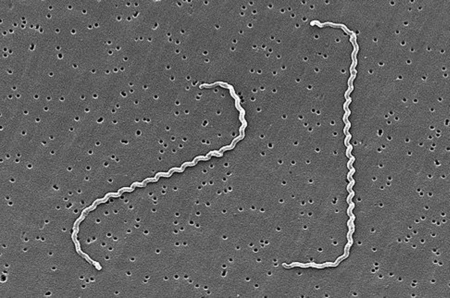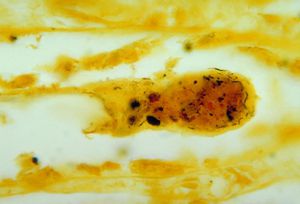Leptospira Interrogans

Leptospira interrogans is a thin, helical shaped bacteria that causes the zoonotic disease known as Leptospirosis. Leptospirosis is considered the most widespread zoonotic disease and can be deadly in severe, untreated cases. The spread of the disease can be attributed to the ability of L. interrogans to thrive in soil and water extended periods of time. The disease is difficult to prevent in humans due to the high amount of variety in serovars of L. interrogans, but current research is moving toward the creation of a human vaccination against Leptospirosis.
Classification
Higher Order Taxa
Bacteria; Spirochaetes; Spirochaetia; Spirochaetales; Leptospiraceae; Leptospira
Species
Leptospira interrogans
Cell Structure and Metabolism
Leptospira interrogans is a gram negative bacteria. The cell is thin and spiral shaped with a hook on each end. It is motile and possesses two periplasmic flagella. The L. interrogans species can be broken down into roughly 250 serovars. Leptospiral serovar diversity results from structural differences in carbohydrate component of lipopolysaccharides. Many serovars are adapted for specific mammalian reservoir hosts. Leptospira interrogans is an aerobic bacteria and possesses both catalase and oxidase enzymes and does not ferment carbohydrates.
Genomic Structure
Mechanisms of Infection
L. interrogans can be spread through the bodily fluids, excluding the saliva, of infected animals. The bacteria can enter the body through skin or mucous membranes and via consumption of contaminated water. Infected wild and domestic animals may continue to excrete the bacteria into the environment for up to several years and the bacteria can remain in soil and water for months at a time.
Symptoms and Impact
Humans

Human infection by L. interrogans is classified as either icteric or anicteric. The anticteric form makes up 90% of infections and is less severe. The icteric form makes up 10% of infections and is very severe. The icteric form is also known as Weil’s Disease. Weil’s Disease is most often due to infection with serovar L. icterohaemorrhagiae, but humans are susceptible to infection via a variety of serovars. Typically, symptoms begin to appear within two to four weeks of exposure. The infection can be divided into two phases: phase one which represents the anticteric infection, and phase two which represents the icteric infection. In phase one, symptoms include fever, chills, headache, muscle aches, vomiting, or diarrhea. These symptoms can often be mistaken for other infections, and in some cases, no symptoms appear. If the infection progresses into phase two (Weil’s disease), symptoms include petechiae, hepatomegaly, jaundice, renal tubular damage and subsequent renal insufficiency. The disease can progress and affect almost all internal organs, producing inflammation and hepatic lesions that lead to organ failure. If the infection and liver/renal failure are not promptly diagnosed and treated, recovery can take months, and mortality can reach 20%.
Other Mammals
Prevention of Leptospirosis
Due to the common transmission of L. interrogans via rodents, one of the most effective methods of prevention in animals is minimizing rodent populations near animal residences. Pets can also be vaccinated against Leptospirosis, but the vaccine only inhibits a handful of serovars. There is no formal method of Leptospirosis prevention in humans. Chance of contraction can be reduced by minimizing or avoiding direct contact with animal excrement or water contaminated with animal waste.
Current Research
Further Reading
[Sample link] Ebola Hemorrhagic Fever—Centers for Disease Control and Prevention, Special Pathogens Branch
References
Edited by Emily Gratke, a student of Nora Sullivan in BIOL168L (Microbiology) in The Keck Science Department of the Claremont Colleges Spring 2015.
